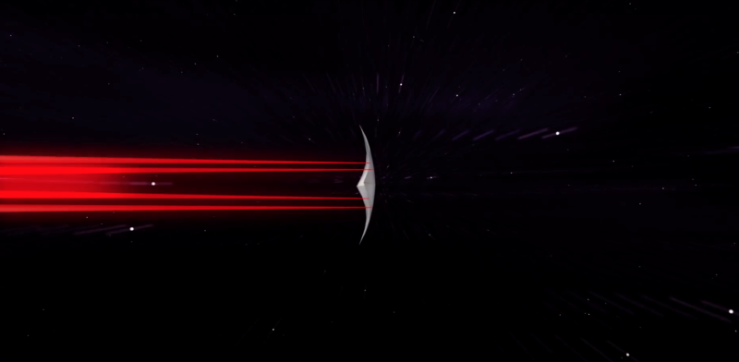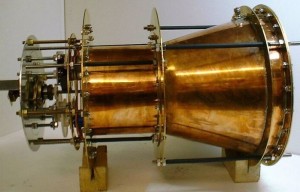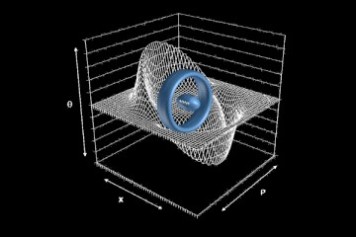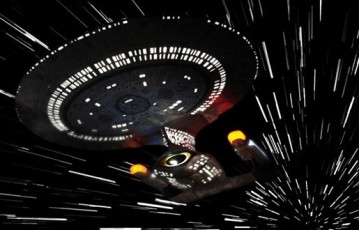PLOT DEVICES FOR SCI-FI / FANTASY WRITERS
T. E. Mark’s Blog

FTL Faster than Light Speed
Essential if we’re ever going to reach another star system.
Crucial if we’re truly going to explore the universe or even our puny little galaxy.
Critical if we absolutely need to beat those Klingons to Beta-Gamma-Epsilon V in the Neutral Zone.
Really important if we want to get away from the nutty Earth of the 21st century, and come back sometime during the 23rd to see if we’ve made any progress towards sanity.
Kind of a treat for those wishing to punch holes in one of Einstein’s more famous theories.
Funding for lots and lots of additional research and cooler than cool equipment, if we can pull it off.
A quick Q & A about FTL research:
What have we discovered thus far?
It can’t be done.
Why not?
The Universe just doesn’t work that way. And besides, Einstein said so.
Are we certain we know enough about how the universe actually works to make such a claim?
Probably not. So, get your degrees in Theoretical Physics and start working on it, smart ass.
Are there ways to get to distant star systems without travelling FTL?
Read ahead, didn’t you. Boy, there’s always someone.
What about warp-drive technology?
Watch a lot of TV, don’t you.
What about the new EM Drive I’ve been reading about?
Excellent question. Actually… No, wait! A spectacular question. Next?
What about wormholes?
Neat idea, and there is a body of evidence suggesting they may actually exist. Unfortunately, since we’ve never found or even observed one, they currently reside as great simulations in really nifty computers and exist as super Plot Devices in Science Fiction literature and films.
Do we really need to get to the other stars?
Need is a funny term. With scarcely an interest in sounding sarcastic, I’ll simply say that, if human beings only sought things they truly needed, we’d still be living in caves in sub-Saharan Africa, and maybe a few other fashionable places.
The Major Issues:
Space is vast.
It’s so vast we don’t even have numbers to apply to its vastness. We use the speed of light, which is actually a speed, and time, which is actually a… uhm… time, to describe the distances. Neither of which are truly distance measurements. We call these light-years, by the way.
This is like saying it’s 471 Sprinting Cheetah minutes from London to Paris. Or, sixteen feisty dolphin days from Bristol to New York.
Think of it this way: That pretty, gently flickering, majestic, eerily sparkling star at the corner of Orion’s belt? The one with the whimsical green glow to it which seems to be calling out your name in some totally incomprehensible language which you, and only you, can hear or understand? Yes, well, it may have exploded and turned into something like a massive lump of x-ray spewing charcoal about the time the Pope crowned Charlemagne in 800 AD.
Light is not only fast, it’s like blazingly fast.
This may be like the understatement of all understatements.
Here are a couple of numbers for you.
Light travels at roughly 300,000 km per second. In America, that’s about 186,000 miles/sec.
To place that into perspective, if you aim a torch (Flashlight) into the night sky and begin counting, by the time you reach four minutes, your light beam is already zipping past Mars on its way to Jupiter.
Needless to say, we have some work to do if we’re ever going to conquer FTL speed and find ourselves out there traversing the galaxy.
Relatively Speaking and Einstein

Much of this conversation, and many of the conclusions drawn, are immediately attributable to Albert Einstein and his indecently difficult to understand Theories of Relativity.
There are two.
The first, your basic, every day, T-shirt and jeans theory of Relativity, called, idiosyncratically, General Relativity, is rather general and has little to do with travelling FTL. It will, however, help you the next time you’re out with friends calculating how much light bends in the presence of an immense gravity field, or how inconvenienced you are by the universe expanding at a faster rate than it was on your last birthday.
The second theory is rather a bit more special. In fact, even Albert thought so when he rolled it out as his Special Theory of Relativity in 1905.
Special Relativity and why FTL is a ‘no-go.’
Special Relativity says many things. (That’s probably why Al called it Special in the first place)
One of the more relevant things it states is that nothing can travel FTL – Faster than the speed of light.
Why?
Because matter (things – you know, you, me, rocket ships, grossly overpriced footwear) tend to expand as they approach light speed. Thus, as they get larger, they require more energy to go faster. And, as they go faster, they get larger, thus requiring even more energy.
This vicious cycle of; expansion-more energy, expansion-more energy, would continue, according to Special Relativity, right up to the moment you neared Light Speed, at which time, you, your rocket, and shoes would have reached an infinite size, thus requiring an infinite amount of energy.
A quick word about infinite
Something infinite is big. It’s so big, in fact, it may even be bigger than space itself, which, according to Douglas Adams in his cosmologically insane, mind-bogglingly brilliant Space Classic, A Hitchhiker’s Guide to the Galaxy, ‘is big.’
Thus, one immediately grasps the difficulty of peering at the concept of one day reaching Light Speed, or even ogling the concept of FTL.
Alternatives to FTL
There are alternatives.
EM Drive. EM stands for electromagnetism. Light, by the way, is a form of electromagnetism.

The really clever guys over at NASA are currently working on it. They’ve made some progress, and if they succeed, this may very well be the answer. BTW, light travels at the speed of light. And since light is a form of electromagnetism, a propulsion system using EM (No rocket fuel needed) could at least get us to Light Speed and ultimately to the stars.
This is a very cool concept, writers, and certainly a worthy plot device for your next outer space novel.
FTL Warp Drive


This is undoubtedly the coolest, most utterly implausible concept available. This is what writing, or reading, Science Fiction is all about.
The concept is straightforward enough. I mean, fold a hunk of space-time into a bubble, with you, your rocket ship, blender, and, you know, other important stuff, in the middle, and slosh on through from point A to point B like a reckless hyena on holiday in Spain.
You won’t actually travel FTL, but you’ll cover the same distance as if you did.
You might see this as yanking the North American plate over the Atlantic Ocean plate, bringing New York to just off the coast of Ireland, cutting your six-hour trip from the states to London down to about 45 minutes.
Or, folding the English Chanel and France into something resembling a biscuit, and hopping through it on your way to Rome in about the same time it takes you to find your keys in the morning.
Wormholes

This one gets used again and again in Science Fiction and Fantasy literature and is similar, in a way, to the FTL Warp Drive.
Simple explanation: Fold space-time into a horseshoe, and travel from point A (Earth, for example) to point B (Let’s say Proxima Centauri, for no particular reason) a distance of roughly 4.6 Light years, in about three minutes.
Sounds reasonable, right?
Obstacle one: Wormholes are purely theoretical. They’ve been manufactured in a laboratory, and, (Here’s a catchy little clause for you) ‘their existence is not inconsistent with General Relativity.’
This is pretty much like saying Charlize Theron and I could be dating soon, as, she being a woman, and I, a man, the possibility does not violate any known principles governing primitive Earth mammals.
Obstacle two: If we were to somehow, someday, manufacture a sizeable wormhole, to keep it from collapsing, we would need a vast amount of something called: ‘Exotic Matter.’
Since scientists have had about the same luck creating this Exotic Matter as they’ve had coming up with a reasonably original name for it, this is nothing one should expect to see or be gliding through in the near future. It is, however, a thoroughly useful Plot device. Though, at this point of the game, near pathologically overused.
Terminology (For readers and writers)
This is where I typically sprinkle you with flurries of whimsical terminology which you, the writer, can use to add legitimacy to your space novels, and where you, the reader, can feel less intimidated by these 80-kilogram terms when you run across them in print.
EM Drive Resonance Chamber: The chamber where the NASA guys are working on the EM Drive.
(Sample Novel Extract)
‘Commander.’
‘Yes, Captain McAfterparty. ‘
‘Are you honestly saying you and Major Issues sent a laser at FTL 1.5 through the onboard EM Drive Resonance Chamber?’
‘The experiment was nearly a complete success, Captain.’ The Commander peered sombrely towards the main viewer at the EM Resonance Chamber now drifting through the morbid but delicate folds of the Crumb Nebula. ‘That is,’ he followed up, ‘I mean, more or less, sir.’
‘Nearly?! More or less?!’ The Captain turned to the screen to see Major Sirius Issues float by still tethered to the Resonance Chamber. He cocked his head and considered waving, but held off. ‘And that’s?’
‘The Resonance Chamber, I’m afraid, Captain.’
‘And…?’
‘Major Issues, Sir.’
An overwhelming, ear-splitting, mind-rattling quiet consumed the bridge of the Atari Pong III.
‘Well,’ said the Captain, cheerfully – turning. ‘FTL is possible after all, then. Hey! Great! The first one’s on me tonight in 10 Aft.’
The crew broke into spontaneous applause.
Superluminal
Means the same as FTL but sounds better. Also gives you an alternative to writing ‘Faster Than Light’ that isn’t an acronym. People hate acronyms. I hate acronyms. I mean, BFD with all the SSDF acronyms.
Tachyons
High energy photons which presumably always travel Superluminal. (Star Trek TNG has used this one often and always incorrectly, and it still makes me happy.)
Transversable Wormhole
A manufactured wormhole that doesn’t collapse, thus allowing something like a spaceship to slip through it on its way to basically anywhere in the universe. This method of travel, if possible, would even leave FTL in the dust.
Highly theoretical, and, once again, heavily reliant on that elusive ‘exotic matter’ that just about everyone’s been talking about these days.
Phase Velocity
Basically refers to the velocity of an electromagnetic wave (an x-ray, perhaps) when passing through something other than a vacuum. Glass, for instance.
These can, and do, exceed the speed of light but are not useful, and just reading the explanation can, and usually does, cause permanent brain damage.
Regardless of the perversely obtuse definition, this is a great term for a Sci-Fi / Fantasy piece. And, trust me, no one will be ringing you up to tell you that you got it wrong.
Time Dilation

Overused, yes, but still a good one.
Refers to something becoming displaced in time – usually, but not always, due to travelling beyond the speed of light.
Quantum Entanglement
I’m really going to ask you to focus and stretch on this one. It’s important.
If two identical particles, say electrons, were separated by some huge distance – like galaxies apart but seemed to do whatever the other one did at exactly the same moment, one would have to assume they were somehow connected. Perhaps by a beam of energy.
But, at such a distance, the beam (tether) would most certainly be travelling much faster than the speed of light.
By the way, Einstein postulated this one and called it ‘Spooky Action at a Distance.’ And I swear I am NOT making this up.
Some additional, almost implausibly cool, terms for you without definitions: Use creatively – flagrantly – recklessly. Without remorse!
Microquasars
Blazars
Chernenkov Radiation
Gaussian Beam
Epiphenomenon of Quantum Decoherence
Quantum Tunnelling
Superluminal Communications
Evanescent Modes
Recession Velocity
Alcubierre Drive
Final thoughts:
I’ve barely scratched the surface of FTL speed in this issue. In all reality, this post could have been a novella.
As a Science and Science Fiction writer, I have an inexhaustible appetite for reading this type of research. I see great value in space exploration and feel genuine satisfaction when scanning recent developments in Physics, Astrophysics and Astronomy.
I believe we will reach the stars one day. And when I close my eyes after a long day, I see visions of our nations, fully united, splitting the vastness of space with Superluminal, EM Drive spaceships, exploring exoplanets, and quasars, and distant Galaxies, and having a blazing good time sending us dazzling photos via Transversable Wormholes.
Two Final Questions:
What will it take to convince our governments to scrap all military spending, and direct the absurd amounts of money we spend on weapons into things like, feeding the hungry, housing the homeless, cleaning the atmosphere, and finding our way to those brilliant bulbs that speckle our night skies?
(and)
Where do I go to sign up to be on one of the first missions into deep space?
I’ve specifically enjoyed writing this issue of my PLOT DEVICES FOR SCI-FI / FANTASY READERS AND WRITERS, and hope you’ve been at least modestly, if not entirely, enriched, intrigued and entertained.
If my work pleases you, consider sharing this with your networking pals and maybe picking up one of my six recently published novels:
‘Love in the Time of Apocalypse’ (Published – June 2017)
‘Alina’ (Published – May 2017)
‘Never a Sun Rises’ (Published – April 2017)
‘Fractured Horizons: A Time Travel Odyssey’ (Published – Jan 2017)
‘…but then, why Mars really?’ (Published – Dec 2016)
‘AHNN’ (Published – Oct 2016)
T.E.Mark
T.E.Mark is a Science Writer, Author, Language Teacher and Violinist. He has written novels for Young Readers, Adult Readers, and continues to write science articles for national and international magazines.
I loved this blog! Thoroughly entertaining, TE. I enjoy science fiction and have had lengthy discussions with my husband on interstellar travel. I do know they were also talking about nuclear propulsion where they continuously fire the engines to propel us through space. I do like the idea of the EM Drive. That sounds like a positive step. Like you, I want us to go back to the stars. I believe our future lies somewhere in the vastness of the universe. When I was a kid, I really thought that we would have colonized the moon by now.
LikeLike
Thank you, Susan. I’m glad you found this issue entertaining and rewarding. Yes, I would have expected us to be further along with space research by now. I believe it’s a simple matter of priorities.
It’s reading through the current research, the stuff that doesn’t make the mainstream news, like the EM Drive, that heartens me and gives me hope. Perhaps things will change. Perhaps we’ll see greater interest in deep space exploration in the years to come.
Keep reading.
I’ll try to keep these articles coming more often.
TE Mark
LikeLiked by 1 person
Thanks, TE! I definitely will.
LikeLiked by 1 person
congratulations MARK! cant wait to read it….
LikeLiked by 1 person
Thank you, Azita. I’m glad you enjoyed this issue. I have a new one just about ready.
TE Mark
LikeLike